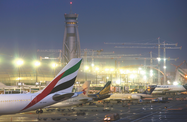The aviation industry appears set to face increasing challenges over the next six months as airlines face lower than expected profits as a result of high fuel costs. However, with Dubai continuing to expand its airport capacity, the emirate is looking to position itself to take advantage of growth markets in South-east Asia.
In early June, Tim Clark, the president of Emirates Airline (Emirates), Dubai’s flag carrier, said that the aviation segment was set to endure a “perfect storm of adversity”. Just days later, the International Air Transport Association (IATA) published its revised financial forecast for 2012, which seemed to echo Clark’s warning predicting that the Middle East sector would see its net profit fall from $1bn in 2011 to $400m this year – a further retreat on the $500m envisaged by the organisation in March.
“The entire airline industry faces difficult challenges ahead due to rising fuel costs and distressed economies,” Clark told OBG. “However, these challenges were not unforeseen, and some airlines were able to act swiftly and implement measures to lessen the impact on their bottom line, while others did not. Those companies that did not act accordingly are suffering the consequences.”
Emirates, however, is in a position to push on with its global expansion plans. Earlier this year, Thierry Antinori , the executive vice-president of sales at the airline, acknowledged that the eurozone crisis was a challenge, but he told Bloomberg the carrier was determined to persevere with its business strategy.
“The … size of our operations makes it possible for us to continue to stick to our growth plan, despite the eurozone difficulties,” Antinori said. “If necessary, we will have contingency plans, but now is not the time for that. Some other airlines are decreasing their number of flights, downsizing or downgrading their products. We will not do that.”
Antinori has also said that Emirates plans to add 31 new planes to its fleet this year, as well as 200 new pilots. The airline’s on-going expansion over the past several years has seen it become the biggest customer for the Airbus A380 superjumbo jet, with 90 of the aircraft presently on order. In line with other carriers, Emirates saw its margins cut in 2011, due to a 44% spike in its fuel bill, but its earnings remained in the black at $409m and its load factors stood at a healthy 80%.
The wider industry’s long-term fundamentals appear strong moving forward. The Boeing 2012 Current Market Outlook predicts that global airline traffic will increase by 5% per year over the next two decades, with a key driver being growth in China, India and other emerging markets. Emirates, with its transit centre located between Europe and South-east Asia, should be well positioned to take advantage of these developments.
Early in August, IATA published data for the aviation industry’s performance in June, and while the figures point toward an overall slowing of growth in demand for air transport due to “weakness in business and consumer confidence”, the Middle East has largely bucked this trend
“Middle East carriers were the strongest performers with demand growth of 18.2%, outstripping a capacity expansion of 13.4%,” the report said. “Load factors stood at 78.6%. In contrast to the overall market, the growth trend in this region has been robust throughout 2012, gaining a further 1.9% in June compared to May.”
Indeed, Dubai International Airport witnessed a throughput of 27.9m passengers in the first half of 2012, a 13.7% spike year-on-year, with India and Saudi Arabia providing the largest passenger volumes. The airport expects to see some 90m passengers a year by 2018.
“We are not simply focused on the local market, but on the global market,” Paul Griffiths, CEO, Dubai Airports, told OBG. “What we are doing is using Dubai as an attractive destination for tourism and commerce, as well as a global long-haul aviation hub.”
Toby Stokes, a partner and the aviation sector leader of Europe, the Middle East, India and Africa at Ernst & Young, told OBG that an extensive route network is vital to the Gulf’s expanding airlines.
“The large Middle East airlines’ corporate strategies are based on having a truly global network and they need to continue to expand to achieve this objective,” he said. “Expansion into newer routes, including those in emerging markets that are considered less conventional, is key to achieving the network scale and connectivity to realise their long-term ambitions of being among the top global carriers.”

